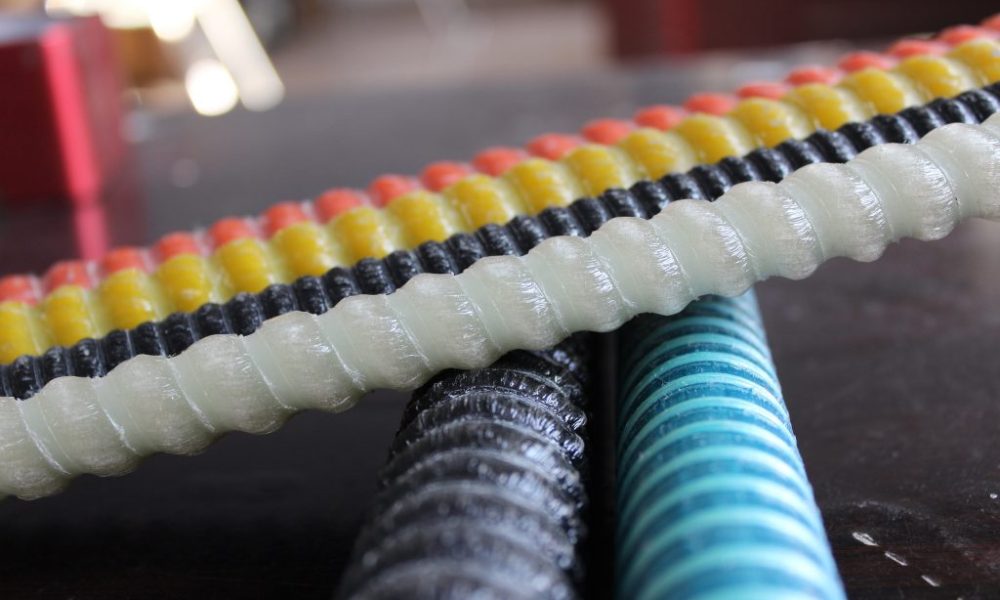GFRP, an acronym for Glass Fiber Reinforced Polymer, represents a composite material that has revolutionized the construction and engineering sectors. GFRP bars, often referred to as GFRP rebar or fibreglass rebar, are a key component within this innovative material family. These bars are manufactured by embedding glass fibres within a polymer matrix, typically made of vinyl ester or epoxy resins. With a polymer matrix and glass fibres, the composite material combines strength and stiffness.
The production process of GFRP bars involves pulling glass fibres through a bushing to create continuous filaments, which are then coated with a sizing agent to enhance bonding. These filaments are subsequently wound onto a bobbin and transported to a pultrusion line. In the pultrusion process, the glass fibres are saturated with the polymer matrix and pulled through a heated die, where they are shaped into the desired bar profile.
Key properties of GFRP bars
Corrosion resistance – A game-changer for harsh environments
Unlike traditional steel reinforcement, which is highly susceptible to corrosion in harsh environments, GFRP bars remain unaffected by corrosive agents such as salt, chemicals, and moisture. This property is particularly crucial in regions with high humidity, coastal areas, or locations where de-icing salts are commonly used. By eliminating the risk of corrosion, GFRP bars ensure the long-term structural integrity of reinforced concrete, even in the most demanding conditions.
High strength-to-weight ratio – Lightweight durability
GFRP bars boast an impressive strength-to-weight ratio, making them an ideal choice for applications where weight is a critical factor. With a tensile strength comparable to that of steel, GFRP bars offer a lightweight alternative without compromising on structural performance. This property is especially beneficial in regions with challenging terrain or areas where transportation and installation of heavy materials pose logistical challenges. The reduced weight of GFRP bars not only simplifies handling and installation but also contributes to the overall durability of the structure by minimizing the risk of fatigue and stress-related failures.
Fire resistance – Withstanding extreme temperatures
In certain harsh environments, such as industrial zones or regions prone to wildfires, fire resistance becomes a critical consideration. GFRP Bars exhibit excellent fire resistance, maintaining their structural integrity even at high temperatures. Unlike steel, which loses strength and flexibility when exposed to fire, GFRP bars retain their mechanical properties, ensuring the safety and stability of reinforced concrete structures. This property is particularly valuable in protecting critical infrastructure and ensuring the resilience of buildings in fire-prone areas.
Applications of GFRP bars in harsh environments
Coastal and marine construction
Coastal regions and marine environments present unique challenges due to the constant exposure to saltwater, moisture, and corrosive elements. GFRP bars have proven to be an excellent choice for reinforcing concrete structures in these settings. Their corrosion resistance ensures that the reinforcement remains intact, preventing the degradation of concrete and maintaining the structural integrity of piers, docks, seawalls, and other marine infrastructure.
Industrial and chemical facilities
Industrial facilities, chemical plants, and wastewater treatment plants often operate in harsh conditions, with the presence of corrosive chemicals and aggressive substances. GFRP bars offer an ideal solution for reinforcing concrete in these environments. Their chemical resistance and durability ensure that the reinforcement remains unaffected, even in the presence of highly corrosive materials. This property is crucial in maintaining the safety and functionality of critical infrastructure in industrial settings.
Bridge and highway construction
Bridges and highways are subjected to constant dynamic loads, including traffic, wind, and temperature variations. GFRP bars’ exceptional fatigue resistance and high strength-to-weight ratio make them an excellent choice for reinforcing these structures. By utilizing GFRP bars, engineers ensure the long-term durability and safety of bridges and highways, even in regions with extreme weather conditions and heavy traffic loads.
GFRP bars represent a paradigm shift in the way we approach reinforcing materials, offering a durable and sustainable alternative to traditional steel reinforcement. Using composite materials, we create structures that withstand extreme conditions.


